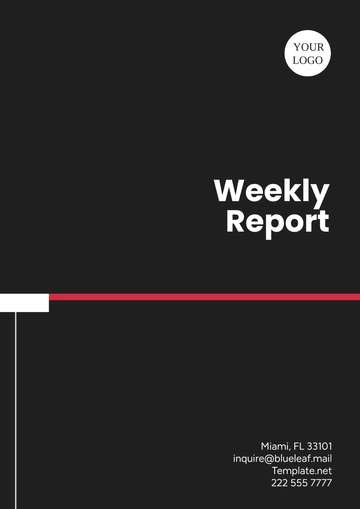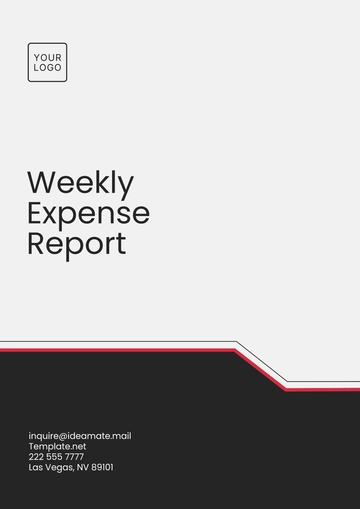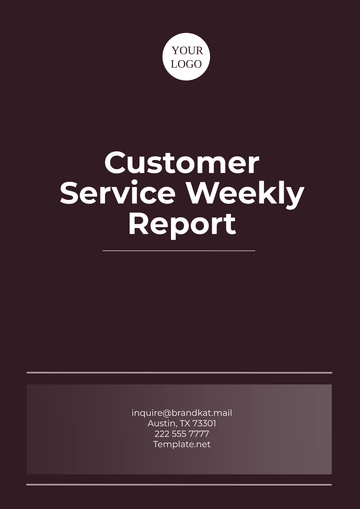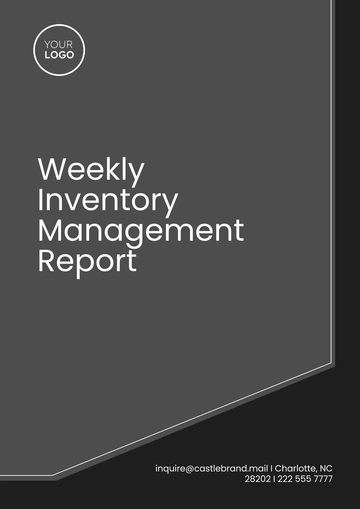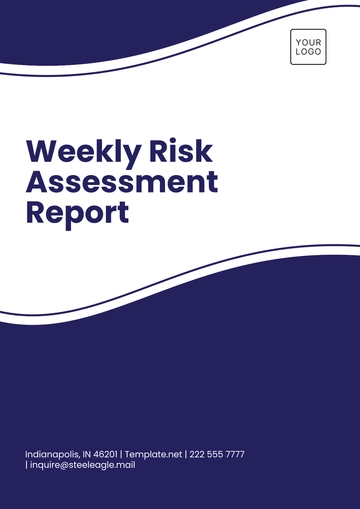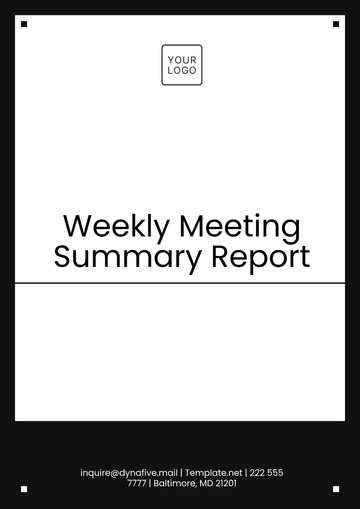Free Weekly Sales Report
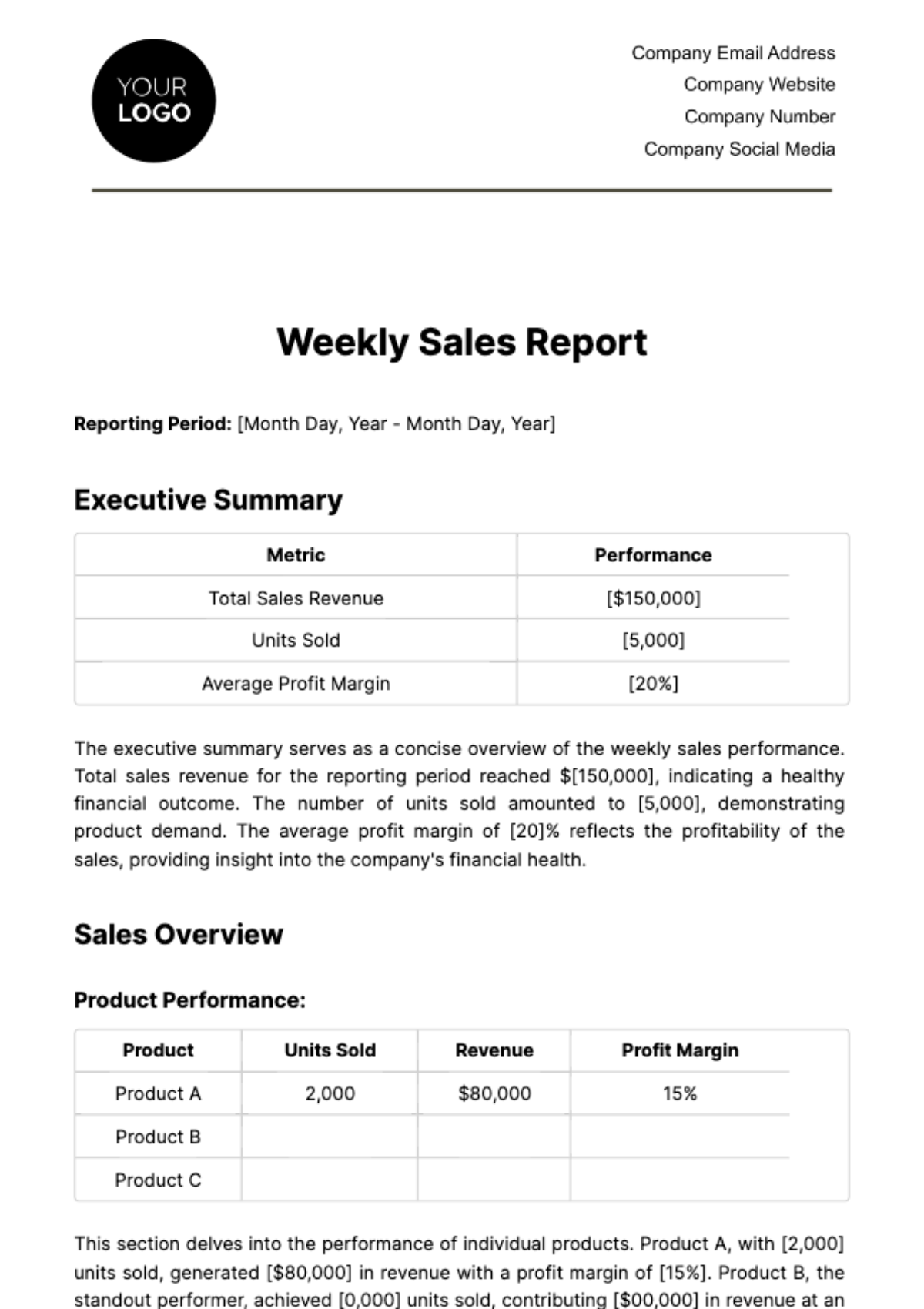
Reporting Period: [Month Day, Year - Month Day, Year]
Executive Summary
Metric | Performance |
Total Sales Revenue | [$150,000] |
Units Sold | [5,000] |
Average Profit Margin | [20%] |
The executive summary serves as a concise overview of the weekly sales performance. Total sales revenue for the reporting period reached $[150,000], indicating a healthy financial outcome. The number of units sold amounted to [5,000], demonstrating product demand. The average profit margin of [20]% reflects the profitability of the sales, providing insight into the company's financial health.
Sales Overview
Product Performance:
Product | Units Sold | Revenue | Profit Margin |
Product A | 2,000 | $80,000 | 15% |
Product B | |||
Product C |
This section delves into the performance of individual products. Product A, with [2,000] units sold, generated [$80,000] in revenue with a profit margin of [15%]. Product B, the standout performer, achieved [0,000] units sold, contributing [$00,000] in revenue at an impressive profit margin of [00%]. Product C, while still performing well, had [0,000] units sold, resulting in [$00,000] in revenue with an [00%] profit margin.
Regional Breakdown:
Region | Sales Revenue | % of Total |
North | $50,000 | 33% |
South | ||
East | ||
West |
The regional breakdown provides insights into sales distribution across different geographic areas. The North region emerged as the highest contributor, accounting for [$50,000] in sales revenue, constituting [33%] of the total. The East and South regions also demonstrated robust performance, contributing [$00,000] and [$00,000], respectively, making up [00%] and [00%] of the total revenue.
Key Performance Indicators (KPIs):
KPI | Performance |
Sales Growth | [12%] |
Customer Acquisition Cost | [$15] |
Customer Lifetime Value | [$60] |
Key Performance Indicators (KPIs) provide essential metrics for assessing overall business health. The Sales Growth KPI indicates a positive trajectory with a [12%] increase, highlighting the effectiveness of sales strategies. The Customer Acquisition Cost (CAC) is [$15], demonstrating the cost-effectiveness of acquiring new customers. The Customer Lifetime Value (CLV) is [$60], indicating the potential long-term value generated from each customer.
Marketing Campaigns
Campaign A
Metric | Performance |
Impressions | 100,000 |
Click-Through Rate (CTR) | 2% |
Conversion Rate | 5% |
Campaign A metrics provide insights into the success of the marketing initiative. With [100,000] impressions, the campaign achieved a [2]% click-through rate (CTR), showcasing engagement. The Conversion Rate of [5]% indicates a successful transition from interest to actual sales, demonstrating the campaign's effectiveness in driving customer actions.
Campaign B
Metric | Performance |
Impressions | |
Click-Through Rate (CTR) | |
Conversion Rate |
The metrics for Campaign B reveal its performance. With [00,000] impressions, the campaign reached a substantial audience. The [0.0]% Click-Through Rate (CTR) signifies engagement, and the [0]% Conversion Rate indicates a successful conversion of leads into customers. Consideration for refinement is suggested to further enhance the campaign's impact.
Recommendations
Optimize Product Mix
The recommendation to focus on promoting Product B is based on its higher profit margin and strong sales performance. Allocating resources strategically to capitalize on its success can enhance overall profitability.
Regional Targeting
Allocating resources to the North and East regions, where sales are robust, aims to maximize revenue. Focusing efforts in these areas can leverage existing strengths and contribute to sustained growth.
Campaign Refinement
The recommendation to refine Campaign B acknowledges its positive aspects but suggests adjustments to improve click-through and conversion rates. Fine-tuning elements of the campaign can lead to enhanced overall performance and return on investment.
- 100% Customizable, free editor
- Access 1 Million+ Templates, photo’s & graphics
- Download or share as a template
- Click and replace photos, graphics, text, backgrounds
- Resize, crop, AI write & more
- Access advanced editor
Discover the ultimate solution for tracking your sales prowess with our Weekly Sales Report Template from Template.net. Effortlessly manage your weekly performance with this editable and customizable tool. Tailor reports to your needs with our intuitive AI Editor Tool, ensuring insights are sharp and actionable. Elevate your sales game today with this indispensable resource.
You may also like
- Sales Report
- Daily Report
- Project Report
- Business Report
- Weekly Report
- Incident Report
- Annual Report
- Report Layout
- Report Design
- Progress Report
- Marketing Report
- Company Report
- Monthly Report
- Audit Report
- Status Report
- School Report
- Reports Hr
- Management Report
- Project Status Report
- Handover Report
- Health And Safety Report
- Restaurant Report
- Construction Report
- Research Report
- Evaluation Report
- Investigation Report
- Employee Report
- Advertising Report
- Weekly Status Report
- Project Management Report
- Finance Report
- Service Report
- Technical Report
- Meeting Report
- Quarterly Report
- Inspection Report
- Medical Report
- Test Report
- Summary Report
- Inventory Report
- Valuation Report
- Operations Report
- Payroll Report
- Training Report
- Job Report
- Case Report
- Performance Report
- Board Report
- Internal Audit Report
- Student Report
- Monthly Management Report
- Small Business Report
- Accident Report
- Call Center Report
- Activity Report
- IT and Software Report
- Internship Report
- Visit Report
- Product Report
- Book Report
- Property Report
- Recruitment Report
- University Report
- Event Report
- SEO Report
- Conference Report
- Narrative Report
- Nursing Home Report
- Preschool Report
- Call Report
- Customer Report
- Employee Incident Report
- Accomplishment Report
- Social Media Report
- Work From Home Report
- Security Report
- Damage Report
- Quality Report
- Internal Report
- Nurse Report
- Real Estate Report
- Hotel Report
- Equipment Report
- Credit Report
- Field Report
- Non Profit Report
- Maintenance Report
- News Report
- Survey Report
- Executive Report
- Law Firm Report
- Advertising Agency Report
- Interior Design Report
- Travel Agency Report
- Stock Report
- Salon Report
- Bug Report
- Workplace Report
- Action Report
- Investor Report
- Cleaning Services Report
- Consulting Report
- Freelancer Report
- Site Visit Report
- Trip Report
- Classroom Observation Report
- Vehicle Report
- Final Report
- Software Report
